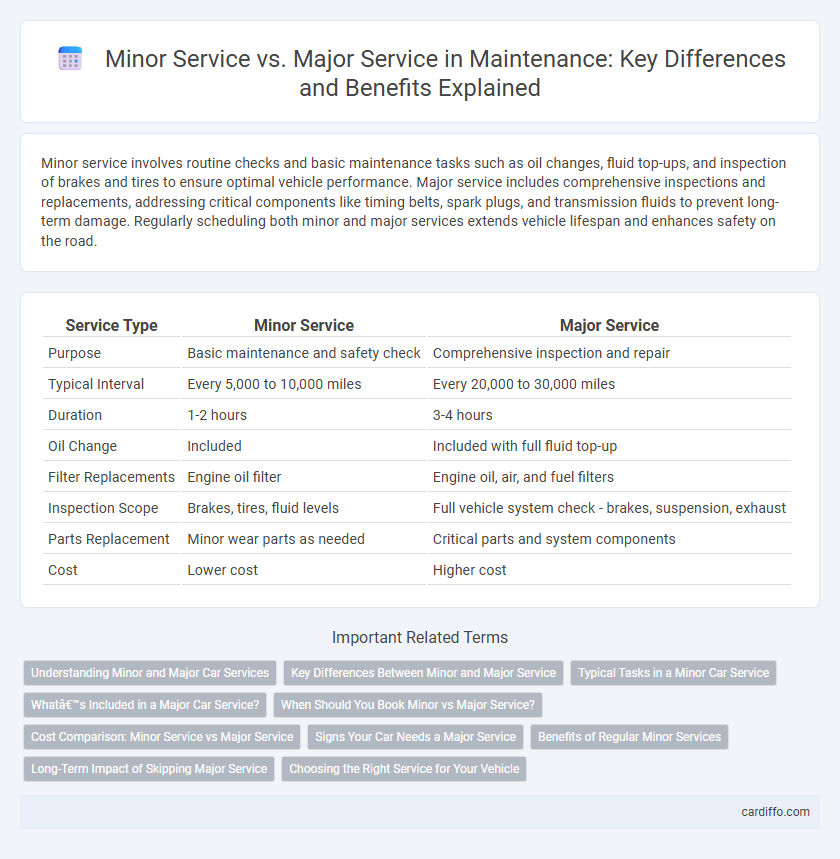Minor service involves routine checks and basic maintenance tasks such as oil changes, fluid top-ups, and inspection of brakes and tires to ensure optimal vehicle performance. Major service includes comprehensive inspections and replacements, addressing critical components like timing belts, spark plugs, and transmission fluids to prevent long-term damage. Regularly scheduling both minor and major services extends vehicle lifespan and enhances safety on the road.
Table of Comparison
| Service Type | Minor Service | Major Service |
|---|---|---|
| Purpose | Basic maintenance and safety check | Comprehensive inspection and repair |
| Typical Interval | Every 5,000 to 10,000 miles | Every 20,000 to 30,000 miles |
| Duration | 1-2 hours | 3-4 hours |
| Oil Change | Included | Included with full fluid top-up |
| Filter Replacements | Engine oil filter | Engine oil, air, and fuel filters |
| Inspection Scope | Brakes, tires, fluid levels | Full vehicle system check - brakes, suspension, exhaust |
| Parts Replacement | Minor wear parts as needed | Critical parts and system components |
| Cost | Lower cost | Higher cost |
Understanding Minor and Major Car Services
Minor car services typically include essential maintenance tasks such as oil changes, fluid top-ups, brake inspections, and filter replacements to ensure optimal engine performance and safety. Major services go beyond the basics, involving comprehensive checks of critical components like timing belts, spark plugs, suspension systems, and cooling systems to address wear and prevent costly repairs. Understanding the differences between minor and major services helps car owners schedule appropriate maintenance intervals, extending vehicle lifespan and maintaining resale value.
Key Differences Between Minor and Major Service
Minor service typically includes basic inspections, oil changes, and filter replacements to maintain vehicle performance, while major service involves comprehensive checks of all major systems, including brakes, suspension, and transmission. Major service addresses wear and tear more thoroughly with replacements and adjustments that extend vehicle lifespan, whereas minor service focuses on routine upkeep to prevent breakdowns. Understanding these key differences helps owners schedule maintenance effectively based on mileage and vehicle condition.
Typical Tasks in a Minor Car Service
Typical tasks in a minor car service include an oil and filter change, inspection of fluid levels, and visual checks on brakes, tires, and lights. Technicians also examine the condition of essential components like the air filter, wiper blades, and battery terminals. These routine checks help maintain vehicle performance and identify potential issues early without the extensive work involved in a major service.
What’s Included in a Major Car Service?
A major car service includes comprehensive inspections and replacements such as engine oil, oil filter, air filter, fuel filter, spark plugs, brake fluid, and transmission fluid. It also involves detailed checks of the vehicle's brakes, suspension, steering components, belts, hoses, and battery health. This thorough maintenance ensures optimal performance, safety, and longevity compared to a minor service that typically covers only basic oil and filter changes along with general vehicle checks.
When Should You Book Minor vs Major Service?
Book a minor service every 6 months or 6,000 miles to address routine checks like oil changes, fluid top-ups, and brake inspections that ensure optimal vehicle performance. Schedule a major service annually or every 12,000 miles to include comprehensive diagnostics, detailed engine assessments, timing belt checks, and replacement of key components for long-term reliability. Timely distinction between minor and major service appointments prevents costly repairs and maintains warranty compliance.
Cost Comparison: Minor Service vs Major Service
Minor service typically costs significantly less than major service due to fewer parts replaced and less labor involved, often ranging from $100 to $200. Major service involves comprehensive inspections and replacements, with costs commonly between $300 and $600 or more, depending on vehicle make and model. Choosing between minor and major service impacts maintenance budgets, where minor service maintains routine upkeep and major service addresses extensive wear and potential future repairs.
Signs Your Car Needs a Major Service
Signs your car needs a major service include persistent engine warning lights, unusual noises, and decreased fuel efficiency, indicating underlying issues beyond routine maintenance. Major service typically involves comprehensive inspections such as brake system checks, fluid replacements, and timing belt assessments that go beyond the scope of minor service. Addressing these signs early can prevent costly repairs and ensure optimal vehicle performance and safety.
Benefits of Regular Minor Services
Regular minor services enhance vehicle reliability by addressing essential maintenance tasks such as oil changes, filter replacements, and fluid top-ups, preventing costly repairs. These services improve fuel efficiency and prolong engine life by ensuring optimal performance and early detection of potential issues. Frequent minor servicing maintains warranty validity and boosts resale value by demonstrating consistent care and upkeep.
Long-Term Impact of Skipping Major Service
Skipping major service can cause accelerated wear on critical components such as the engine, transmission, and brake system, leading to costly repairs and reduced vehicle lifespan. Minor services primarily address basic maintenance, but without the comprehensive checks and replacements in major services, hidden issues can escalate unnoticed. Regular major service ensures long-term reliability, optimal performance, and preserves vehicle value by preventing severe mechanical failures.
Choosing the Right Service for Your Vehicle
Selecting the correct maintenance service ensures optimal vehicle performance and longevity; minor services typically cover essential checks like oil changes, filter replacements, and fluid top-ups, while major services include comprehensive inspections, timing belt replacements, brake system checks, and detailed diagnostics. Vehicle manufacturers recommend service intervals based on mileage and time, so consulting your owner's manual helps determine the appropriate service type to maintain warranty compliance and prevent costly repairs. Prioritizing the right service based on your vehicle's age, usage, and condition optimizes safety, fuel efficiency, and overall reliability.
Minor Service vs Major Service Infographic

 cardiffo.com
cardiffo.com